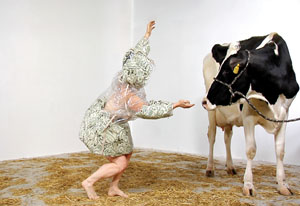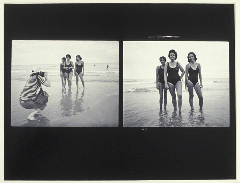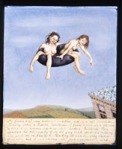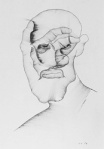
On a recent visit to the DeCordova Museum in Lincoln, MA, I was amused at seeing a toddler sitting on a bench as he watched, with rapt attention, a huge wall-to-wall video of a naked middle-aged woman who was wearing a transparent raincoat partially filled with dollar bills, in a large, hay-filled stall. The woman seemed to be trying to get the attention of a disinterested cow who did nothing for 8 minutes but chew its cud. The toddler and the 10 or twelve adults sitting on a long bench opposite the video wall seemed fascinated. My friend Sheila and I were vaguely amused, but on the whole, thought the cow had it right.
Carlson/Strom: New Performance Video is composed of four room-sized video installations–the first major museum presentation of the collaborative work of choreographer and performer Ann Carlson and video instalation artist Mary Ellen Strom.
In what a DeCordova writeup describes as “elegant, sharply executed and humorous”, the artists present recent performance videos that serve as “critical re-evaluations of cultural and historical narratives” fusing visually spectacular video and the medium’s legacy as a tool for social change. One video– footage of real lawyers mugging it up in front of an elevator, is relatively funny.
Others, focused on “the moving body within a range of “lasndscapes:” the physical western vista, the economic terrain of late-capitalist America–Guatemalan workers on a beach, seemed sad, even tragic.
No doubt the artists are breaking artistic barriers, making important statements in order to get us think about society and our relationships to it. The videos are beautifully done–and maybe I’m being unfair, but I wonder whether, given the reality of life today, Carlson and Strong might be telling us more about their own removed attitudes than than eliciting new understanding on our part.
The installation, curated by Dina Deitsch, is worth seeing, but Sheila and I were more taken with”Face to Face, “ presented as a challenge “to our conventional understanding of portraiture by asking us to reevaluate the complexity of the genre and, by extension, representation itself.”

In a diptych, photgraphers Dick Lebowitz and Tom Young show, in one photo, three women on a beach; in the other, the photographer who is taking the picture. ” In another photo, “Karl Baden violates the singular ‘I’ by fragmenting his own body. Multiple mouths and eyese suggest that the human subject is a composite rather than a finite whole.”
I agree with curatorial fellow Nina Bozicnik that the images bring up questions of identity, portraiture and representation. But, meaningful as they may be, most of the photos are actually fun/interesting/pleasing to look at.
We had a harder time with Tabitha Ververs’ “Narrative Bodies, “ which includes sixty (!) paintings and sculptures highlighting ” the artist’s feminist engagement with tradition and myth. 
“Knives carved out of bone become the surface on which female perpetrators of violence throughout history are incised using the scrimshaw techniques.”
Work from a more recent series of meticulous acryllic paintings on canvas challenges gender roles by depicting women with tails, “human” creatures with four legs and male and female anatomy, a mermaid with a split tail and the like.
Another series, exploring the relationship of humans to the sea, is painted on shells in an ancient and intricate Japanese tradition.
Vevers’ pale blues, pinks, peac hes, and gold prolific are lovely but the exhibit, curated by Nick Capasso, is, ultimately, disturbing–and no doubt, meant to be.
hes, and gold prolific are lovely but the exhibit, curated by Nick Capasso, is, ultimately, disturbing–and no doubt, meant to be.
Sheila and I were most impressed by a retrospective of the work of the late Boston University art professor Harold “Red” Tovish, (1921-2008), curated by Bozicnik.

We especially liked a display of six bronze sculptures showing the artist’s face and head in a range styles including cubism, surrealism and what the DeCordova describes as “contemporary biomorphic abstraction.”
Our only disappointment was that by late Sunday afternoon, the cafe had closed so we were too late to sip peach iced tea on the deCordova’s lovely terrace.
But the provocative art, gardens, outdoor sculptures and view on this early spring day were well worth the trip.
The DeCordova Museum and Sculpture Park is located at 51 Sandy Pond Rd
Lincoln, MA 01773 781/259-8355. All four exhibits will be up through May 17.
New Cambridge Observer is a publication of the Harris Communications Group, www.harriscom.com.



